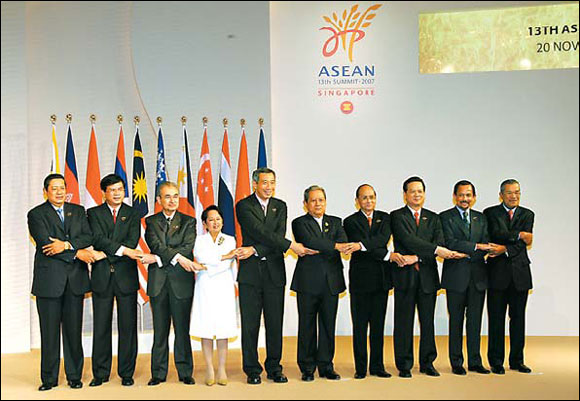Charter lays foundation for 'One ASEAN'
|
Cambodian Prime Minister Hun Sen (first from right) at the 13th ASEAN Summit held in Singapore in November 2007. During the meeting, all the member States endorsed the ASEAN Charter, which provides a legal identity and an institutional framework for the group. |
The signing of the ASEAN Charter in Singapore on November 20, 2007, during the 13th ASEAN Summit, was perfectly in keeping with the theme and tone of the event: "One ASEAN at the Heart of Dynamic Asia".
After more than two years of careful consideration, writing, rewriting and deliberation, the charter has finally been compiled.
This is a culmination of the long process, stretched out over some 37 years, of reaching a decision on the need for such a document.
However, when the time came to agree and sign, there was no hesitation on the part of any of the members.
ASEAN Secretary-General Ong Keng Yong noted this as he said: "It is a credit to us that all ministers endorsed it with no further comment, because we have done all our homework very well."
It has been acknowledged within the region that there is a strong and very real need for the member states to create a solid bond and come together politically, economically and socially within a clearly defined framework.
This impressive and important goal is eloquently captured within the guidelines of the charter, as the need to "strengthen existing bonds of regional solidarity to realize an ASEAN community that is politically cohesive, economically integrated and socially responsible, in order to effectively respond to current and future opportunities."
In response to the creation of the charter, Ong said: "I think this is a good document to start off our new ASEAN era."
The man at the helm of this ASEAN summit and one of the charter's most staunch advocates, Singaporean Prime Minister Lee Hsien Loong, summarized this great opportunity when addressing the opening ceremony of the ASEAN Business and Investment Summit on November 17.
"Asia is a major driver of global growth and ASEAN is right in the center of the action. Our countries offer complimentary advantages to businesses, and a neutral core around which the rest of Asia can build economic ties, and a regional framework of cooperation.
To sustain this, ASEAN has to become more integrated and cohesive. Only thus can we keep up with larger and stronger economies like China and India," said Lee.
On the opening day of the 13th ASEAN Summit, this long-awaited legal and institutional framework became reality and was finally put in place.
So now, 40 years after its inception, this group of Southeast Asian countries, comprised of Cambodia, Indonesia, Malaysia, the Philippines, Singapore, Thailand, Brunei, Vietnam, Laos and Myanmar, has taken its biggest step to date in solidifying this 37-year discussion and making the charter a reality.
(China Daily 04/10/2008 page26)















